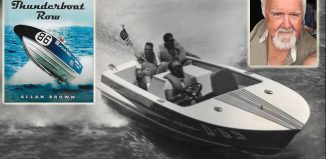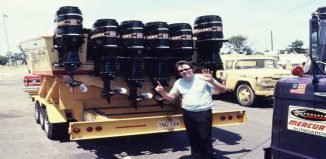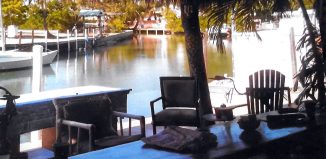In 1989, I went to work for Gentry Transatlantic via my pal, John Connor. John was best known for being Betty Cook’s two time World Champion (Real UIM champion) throttleman. He was much more than that. He throttled Tom to several world titles in the Superboat (read: conspicuous consumption) class, and was project manager on the “Gentry Eagle” a 110’ long, 80MPH monster that carried 18,000 gallons of fuel for its 11,000 HP of hungry engines. The “Eagle” was designed by Peter Birkett (Peter, you will be glad to see that you got your other ‘t’ back) and was to break the Miami/Nassau/Miami speed record, along with Miami-New York and the Transatlantic all-time records. My single best JC memory comes not from the ocean, where he ranks as one of the best ever, but from beach.
In the early 80’s, our local club, OPBRA, conducted a race for inflatable boats to race from Key Biscayne to Fort Lauderdale and back. John entered a 14’ blow-up boat which he had rigged at Mercury Marine’s Lake X. He had raised the top speed to 50mph from 35, but confided in me that there was a Scandinavian factory team there with a slightly faster boat. I wandered over and talked to the Adonis looking Swedish chaps, ostensibly to get information for a big bet, and they told me that they were faster in the rough and the smooth water. We were drinking (and watching) Heinies on the beach, when John came over and said “Here’s my plan. The end of the race is that picnic table over there,” pointing at the officials’ table, about 30 yards from the beach. The intention of the race committee was to have the boats beach, and mosey up to the table. “I am going to cut out a few steps.” Sure enough, at the end of the race, the blonde guys were pulling their boat up on the sand, when John flashed by at 50, and came up the corridor that my fellow Heinie watcher/drinkers had cleared from the beach to the table. The blondes were awestruck. John and his co-pilot, Jim Meyers, won overall, and looked like they had just won a bare-knuckle fight. You could just see what an intense SOB Connor was.
After Gentry’s successful Transatlantic record, the Aga Khan built a 236’ 75,000 HP behemoth, “Destriero” and broke Gentry’s record by a few hours. Tom did not like that. He commissioned Connor to convert the “Eagle” into the world’s fastest yacht, and to design, from scratch, a boat that could set an historic record, crossing the ocean at 100 MPH.
I had been developing new products for Teleflex, Inc. for a couple of years, and constantly got shot down by the sales prevention department (legal). When John offered me a spot, I jumped in with both size 13’s. I had been the original project engineer on Sir Richard Branson’s first Transatlantic racer, “Virgin Challenger”. Never mind that it sank 116 miles from the finish, while beating the old record held by the SS “United States” for the previous 45 years. For the first year or so, we chopped up the poor old “Eagle”, and ‘yachted it out’. We cut out 8,000 gallons of fuel capacity, leaving only 10,000 gallons for cruising. It really came out nice! The speed dropped from 80 MPH to 73 MPH, length went up from 110’ to 113’. The world’s fastest megayacht.
Some of the unique features included a large ballast tank forward to counter the fact that the ship was balanced waaaay aft for top performance. Upon entering port, it was possible to pump enough water forward to bring the beds, tables, wine glasses, etc. perfectly level. We fared the running lights into the hardtop, and the radars into a mast. The cockpit was spiffed up with black leather on the seven Recaro seats, and a ‘Star Wars’ door that went ‘pssshht’ and opened and closed automatically when one stepped in front of it. Mechanically, we built the air supply for the twin 3600 HP MTU Diesels and the 4500 HP Lycoming turbine into the ‘eyebrow’ area of the flybridge over the windshield. We designed our own hooked vane separators and demisters and had them made. The ultimate air volume test was to be able to open the engine room door at WFO, and the ultimate water test was to bury the bow all the way to the wing doors in the Aegean Sea, and not get a drop of water in the engine room.
That job finished, we started in earnest on the new boat. We invited everyone who thought they had an appropriate design for the hyperspeed ocean crosser to give us a design (No cocktail napkins), and we would thoroughly test it in our new ‘free-tow’ model basin in the New River cutoff area. As you might imagine, we had some real doozies. All in all, we tested close to a hundred designs and variations. We built a 19’ lightweight catamaran towboat, designed by Dieter Schulze, fully instrumented, with a boom out to port, and powered by a 200 HP Merc for testing at 200 MPH scale speeds. We had an electronic load cell to measure drag, angle measuring gear, Magnahelic pressure gauges, an AC generator to power the blowers which levitated the model, and some secret stuff. We even built an enclosure for a video camera to give us tunnel view. For control, Harry Schoell built us a scale model of the Gentry Eagle, which had just been officially test by the US Navy. We “blind tested’ our model, and compared our results to theirs. We were right on. This gave us the confidence to go waaaay out from there.
One of the submitters was Chris McKesson, who had been an official of the Advanced Ship Design section of the Defense Dept. Logically, his design was the most efficient of all the models that we tested. The winner was 185 feet long, 50 feet wide, twenty-four feet high, hard sided, high deadrise, air supported, 38,000 horsepower, million pound, 100 knot MONSTER. Along the way, we picked up seven 8,000 HP Allison turboshaft engines. Four of them were from the US Marines’ “Osprey” program, and the other three were from the HLH heavy lift helicopter program. We intended to have four of them turning surface drive propellers, and one powering a 5,000 horsepower air blower (donated by the US Navy from the SES 100 program) lifting the ship. Good news and bad news. Good: The engines were nitrogen encapsulated and ready to go. We bought them for a song. Bad: Both projects were still classified, and we had no access to controls, wiring harnesses or diagrams. Each engine had two “Cannon” plugs, with about 100 wires each.
ENTER, EJ POTTER
Connor came to my ‘Skunk Works’ office one morning and said “I think I have found a guy who can solve our turbine problems. He is a little wacky, but brilliant. I want you to work with him and evaluate him. If you think he can do it, we will keep him. If not, we will keep looking”. The next day, EJ (not E.J.) Potter showed up in an old truck full of junk. “Let me see one of those whistlers”. I took him over to the storage area and we removed the top half of one of the nitrogen purged Allison storage containers. The engines were about ten feet long, and three feet in diameter. EJ looked at the wiring terminus and said “Piece of cake! We’ll just clip off a couple hundred wires and run it manually”. “Huh?” We went to lunch and listened to his plan. Plan 1. Build a dynamometer to run all the engines. The dyno will consist of a frame twenty feet long, with the Allison on one end, and the compressor section of a Pratt and Whitney turboshaft engine from the “Super Guppy” rocket stage hauler on the other. (Sounds easy. What could possibly go wrong?”) He laid out his plan for the control system, and considering that I had won a few ‘wacky’ awards myself, it seemed at least possible.
One of the controls was to be an overspeed shutdown. Overspeed burst on that engine was 11,750 RPMs. EJ’s plan was to make a disc of 1” thick steel, 12” in diameter that would turn with the output shaft of the jet engine. Bolted on the disc would be a pair of one quarter inch diameter spring steel rods which would magically straighten out at 11,500 RPMs, and sever the fuel control cable, just above. EJ brought in a strobe light and a very powerful DC motor to spin the disc at 410 MPH! It took us 16 days to make it work, but, by God we did it. I had visualized the shaft breaking, and the fifty-some pound disc making about 600 trips around and through my little lab.
“How are we going to read the torque?” “Easy. We will make the “push side” of the Guppy compressor mounts air cylinders with air fittings on the bottom. We will pressure them with 100 PSI air, and measure the travel. That will tell us the torque”. “Huh?” We made some aluminum cups with air fittings on the bottom and mounts on top. We sat EJ’s truck on them, and it went just like he said. As I got know and love EJ, I discovered that he was the original V8 Chevy motorcycle dragger, who was known the world over as “The Michigan Madman”. He did quarter mile runs in a dozen countries with his bike. He would put the bike on the rear stand, wind it up to 7,000 RPMs, and push it off the stand and hold it wide open. He would go a quarter mile in 8 or 9 seconds, while burning the tire all the way. Broke his back, neck, and an arm or two. Didn’t seem to bother him. “Only time it bit me in the ass was when the engine would lose power, and get traction. Blow over backwards every time” he said, nonchalantly. He also held the record for electric powered dragsters. He took an Allison 1710 P51 V12 engine, fastened to a jet starter/generator, and a couple of ¼ mile long copper strips. He went 124 MPH in the quarter. You could see that he wasn’t easily cowed by a project.
John Connor didn’t share our enthusiasm. “OK. I will go along with you two if you can show me an engine running in a month or so. No load. Just running and throttling at a low level.” “Alrighty, then! Here we go!” We built the dyno bed, and mounted the first engine. We clipped off every wire on the engine. EJ designed and mounted a pneumatic throttle control utilizing internal engine pressure to open the fuel valve. “Christ, Brownie, it ain’t much more than a self-powered blowtorch.” I built a sequential starting system, using three giant 12 volt batteries. They were wired to join the series one at a time, going from 12 to 24 to 36 volts to bring the engine to about 24% speed to start. We put all the that we needed to touch on the starboard side of the engine. “If it seizes up at full RPM, it will flip the dyno and all about two and one half times to the left, and we don’t wanna be there.”
On a sunny day, in October 1994, EJ and I did our thing. With the rig on a trailer, we towed it to the end of the lot. The whole crew from the area watched as EJ called “Battery one! 10 percent! Battery two, 15 percent! Battery three, 20 percent! Twenty-two percent! Twenty-four percent! Fuel on. Ignition on. WHOOOOSH! Batteries off. She’s running! With a tiny knob, he could run the speed up and down like he was tuning a radio. He ran it up to 65% and vaporized a small tree. God, this is fun!
Two weeks later, on the worst day of my life, Tom Gentry flipped his world record holding catamaran in the Key West World Championship, ultimately dying of his injuries. The family told us to close the doors and go home. Damn!









